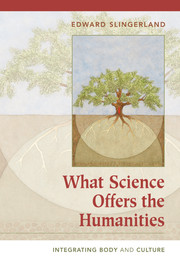Book contents
- Frontmatter
- Contents
- Figures
- Preface
- What Science Offers the Humanities
- Introduction
- PART I EXORCISING THE GHOST IN THE MACHINE
- 1 The Disembodied Mind: Problems with Objectivism
- 2 They Live Among Us: Characterizing Postmodernism in the Academy
- 3 Pulling the Plug: Laying to Rest Postmodern Epistemology and Ontology
- PART II EMBODYING CULTURE
- PART III DEFENDING VERTICAL INTEGRATION
- Conclusion
- Appendix: Embodying Culture: Selected Bibliography and Other Resources
- References
- Index
2 - They Live Among Us: Characterizing Postmodernism in the Academy
Published online by Cambridge University Press: 05 June 2012
- Frontmatter
- Contents
- Figures
- Preface
- What Science Offers the Humanities
- Introduction
- PART I EXORCISING THE GHOST IN THE MACHINE
- 1 The Disembodied Mind: Problems with Objectivism
- 2 They Live Among Us: Characterizing Postmodernism in the Academy
- 3 Pulling the Plug: Laying to Rest Postmodern Epistemology and Ontology
- PART II EMBODYING CULTURE
- PART III DEFENDING VERTICAL INTEGRATION
- Conclusion
- Appendix: Embodying Culture: Selected Bibliography and Other Resources
- References
- Index
Summary
A case could be made that everything interesting that has happened in “thought” – philosophy most broadly understood – in the past hundred years or so is at least foreshadowed, and in many cases clearly laid out, in the writings of Friedrich Nietzsche. Unfortunately, those inspired by Nietzsche's critiques of objectivism did not also follow his lead back to the body and the biological roots of human cognition, but rather seem to have, in the end, fallen into the very sort of idealism and intellectual “Tartuffery” that Nietzsche so despised. The popularity of postmodern and poststructuralist theory in the heady years of the 1970s and 1980s is understandable, and it would be unfair to slight their contributions as an important reaction against the sort of unreflective, culturally myopic, naïve Enlightenment realism that dominated the Academy at that time. Its appeal as part of the post-1960s Zeitgeist is also undeniable, with its questioning of authority, celebration of cultural diversity, and opposition to pervasive racism and sexism. It is also all too easy to caricature postmodern theory, or to present a straw-man version of it, and I will do my best to avoid doing so here. Postmodern theorizing has in innumerable ways changed the landscape of the humanities for the better. It has given us an increasingly nuanced picture of human sexuality and gender identities, exposed widespread cultural myopia and intellectual imperialism, and redirected scholarly attention away from often unrepresentative and moribund high intellectual traditions toward the richness of cultural experience as it is lived on the ground.
- Type
- Chapter
- Information
- What Science Offers the HumanitiesIntegrating Body and Culture, pp. 74 - 98Publisher: Cambridge University PressPrint publication year: 2008



